With the support of the Eötvös Loránd Research Network (ELKH) planned archaeological research in the area of Zalavár-Vársziget took place in 2022 under particularly difficult conditions. The southern third of the site has the most complex history and it is the part that was most disturbed by later interventions. Under the leadership of Miklós Béla Szőke, a scientific advisor with the Institute of Archeology at the ELKH Research Centre for the Humanities (RCH) and Ágnes Ritoók, an archaeologist with the Hungarian National Museum the specialists excavated the remains of the Benedictine monastery founded in 1019 by King Saint Stephen as one of the projects being carried out in cooperation between the two institutions. The results provide a glimpse into significant chapters in the history of the Carolingian and Árpád eras.
 Starting the excavation
Starting the excavation
In the early 840s, the southern extension of Vársziget was demarcated by a wide and deep fortification ditch for the fortified manor houses of Pribina and Kocel (referred to in contemporary sources as Priwina and Chezil). The Carolingian Saint Mary's Church consecrated on 24 January 850 was also built inside this area at a later date. With these structures serving as a basis King Saint Stephen founded the Benedictine monastery on the site, whose church – the renovated Saint Mary's Church – was consecrated in 1019 and dedicated to Saint Hadrian. The monastery was rebuilt and expanded several times in the Middle Ages. It was fortified in the 15th and 16th centuries and then rebuilt into an end castle during the wars against the Turks. Together with the remaining parts of the monastery and the church it was blown up in 1702 by order of Leopold I.
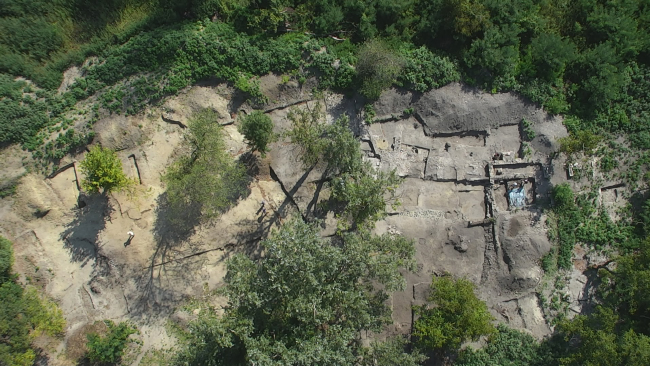 Drone footage of the excavation site
Drone footage of the excavation site
The stones from the ruins were then hauled away to build the surrounding roads and embankments, and the location was used as a sand mine, which has grown deeper and deeper since the mid 19th century and now encompasses an area of around 1,500 m². Although Vársziget was one of the first archeological sites to be discovered in Hungary, excavations documented from 1841 and 1881, during this year's excavation the researchers confirmed that the former Saint Mary's Church, which later became the Saint Hadrian's Church was destroyed all the way to the bottom of the foundation walls. However, a final verdict will only come next year, when the specialists will reach the level of the subsoil everywhere, which will allow mapping the possible changes at the bottom of the foundation trenches. It is a hopeful sign that the researchers found a few more burial sites surviving in better condition in the area south of the church.
 Grave No. 2/22
Grave No. 2/22
Unfortunately, the destruction of the site continued in the 20th century. In the 1930s Gyula Bittera, famous for his part in planting the Tihany peninsula with lavender, built an essential oil distilling plant at the southern edge of the mining pit, which also included a grinding room, a well and a drainage shaft. Their brick walls and concrete pillars, standing on stone rubble foundations and laid on yellow, sandy mortar, were built on the remaining foundation walls, or on decaying layers of them, of the Árpád-era monastery.
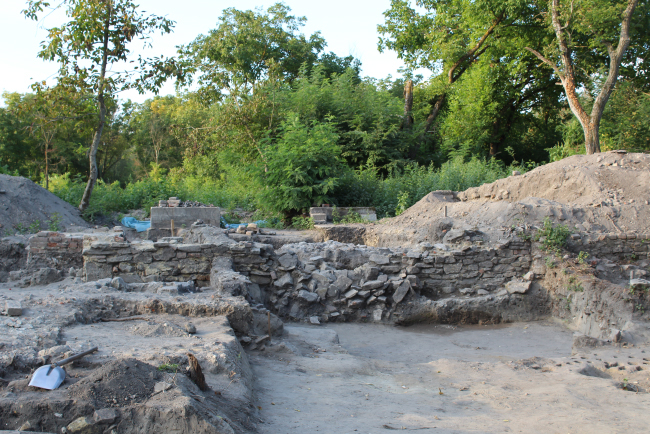 Remains of Bittera's essential oil distillery
Remains of Bittera's essential oil distillery
The systematic archaeological excavation of the site began in the early 1950s. Between 1963 and 1966 Ágnes Cs. Sós, an archaeologist with the Hungarian National Museum also tried to clarify what remained of the monastery and its church at the southern edge of the mining pit. However, the excavation with its narrow exploratory trenches yielded only modest results: it did not help to understand the connections between the different phenomena and in some cases even destroyed remaining evidence.
Despite the various modern-day disturbances and damages, there are fortunately several surfaces on the site that have remained untouched since the Middle Ages. After the removal of the turf layer, a strip of brick, stone and mortar debris one meter wide and approximately 17 meters long running north–south from the southern edge of the mine pit marked the location of the eastern wall of the Árpád-era abbey, but neither the former surface level belonging to the wall nor the demolition level could be documented any further. All that remained were the lowest layer of rubble filling of the foundation ditch about 25-30 cm thick and the foundation itself, consisting of piles densely driven next to each other. Running parallel to this wall, six meters west of it was another wall with a pile foundation, which may have enclosed the last room of the eastern wing of the monastery quadrangle.
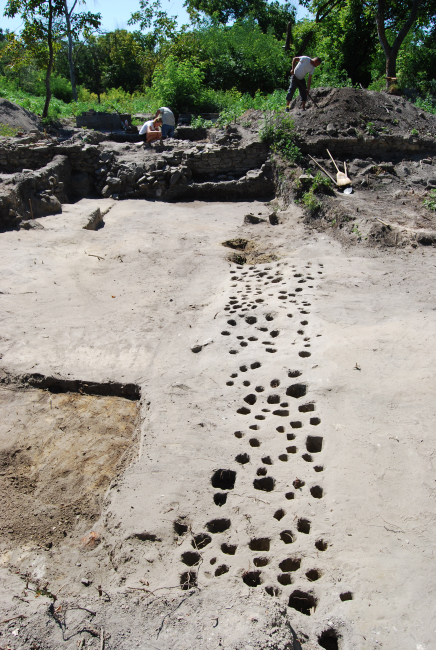 Pile foundation of the monastery wall
Pile foundation of the monastery wall
One of the pile holes yielded a denarius coin from the reign of Béla IV, which the researchers found in the den that a fox had dug there. In later centuries the monastery was continuously improved, expanded and fortified. The eastern wall was subsequently reinforced in the excavated section with an external buttress and on the inner side it was joined by two wall sections built at different times with different colored mortar ‒ either buttresses or internal dividing walls. Located in the vicinity of the southeast corner of the eastern wall were piles of a smaller diameter, filled with decayed organic matter and arranged in a semicircular arc, which may have belonged to the foundation, around 70-80 cm wide, of the round tower erected when the southeast corner of the wall was demolished and immortalized in the drawing by Giulio Turco in 1569.
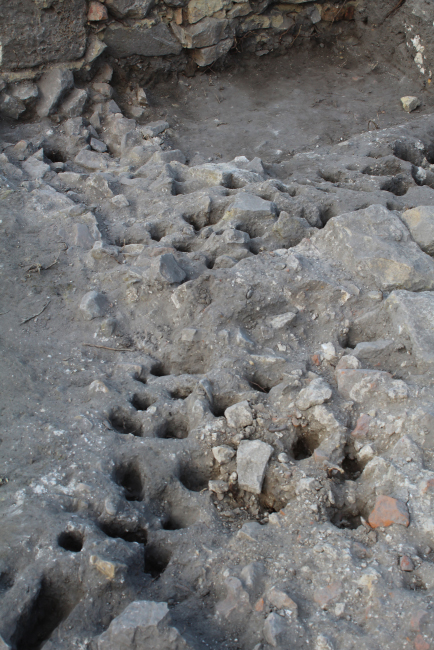 The pile foundation of the corner tower
The pile foundation of the corner tower
Finally, along the outer and inner sides of the eastern wall large wooden posts were dug at a regular distance from each other where this section of the wall, which had already weakened in previous centuries, was reinforced with planks. The palisade erected to protect the southern wall section – whose wooden structure is indicated by numerous iron nails and clamps – was filled with large stones, which fell apart after the wooden structure rotted. While cleaning the layer of debris above the southern wall section the archaeologists found a fragment of an exquisitely beautiful, alabaster-like statue made of so-called pipe clay, which, based on its resemblance to similar objects, was made in a workshop in the Netherlands, perhaps in Utrecht in the second quarter of the 15th century.
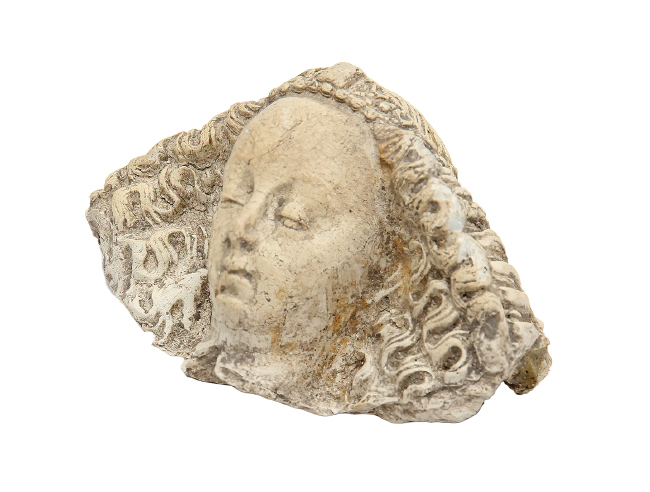 Head fragment of the angel statue
Head fragment of the angel statue
Directly at the southern edge of the mine pit the researchers discovered a 2×2 meter stove made of brick and stone with a sunken, mortar-floored meter-wide forecourt on the east side. The debris filling the forecourt concealed a large number of 15th-century pottery fragments, an iron spur and an iron knife sheath. The stove extended eastward to the base of the eastern wall of the monastery, and even cut into a small section of it. Also found in the area to its south were the remains of another, less intact stove of similar design. The researchers will be able to clarify exactly which construction phases of the monastery the two stoves can be linked to when the excavation continues.
 The first stove and its forecourt
The first stove and its forecourt

